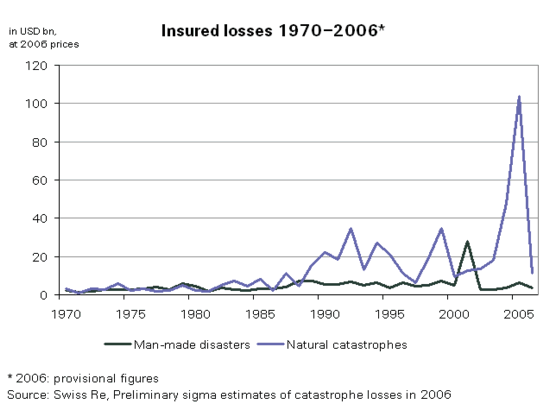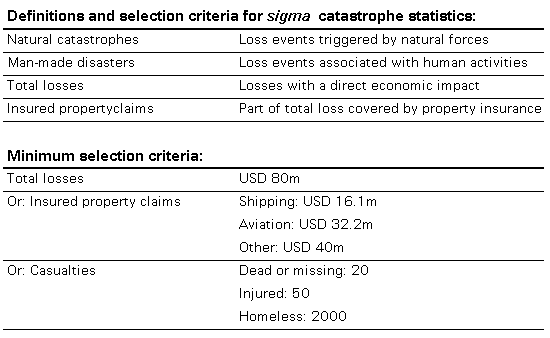According to preliminary estimates, natural and man-made catastrophes triggered total economic losses of around USD 40 billion, and cost property insurers worldwide USD 15 billion in 2006. Earthquakes, cold spells, windstorms and also shipping disasters claimed numerous victims. In all, an estimated 30 000 people lost their lives in catastrophes.
20 Dec 2006
Insured claims of just about USD 15 billion
After years of record losses, property insurers appear to be getting off lightly in 2006: catastrophe losses of only USD 15 billion will allow them to replenish their risk capital, depleted by record payments for hurricane damage in 2005 and 2004. Up to now, only three loss events in the billion-dollar range have made themselves felt: two tornados in the US and a typhoon in Japan (cf Table of the most costly insured losses, below). Among the last 20 years, 2006 has produced the third-lowest insured losses, after 1997 and 1988. This is attributable mainly to the quiet hurricane season in the US and surrounding countries. Unlike in previous years, Europe has also been spared expensive catastrophes up to now; however, the time for winter storms (remember Lothar and Martin in 1999) and floods (for instance �Christmas floods� on the Lower Rhine in 1993) is by no means over. And finally, no major industrialised regions have been hit by earthquakes, and very expensive man-made disasters � such as aircraft crashes or large-scale fires � have been conspicuous by their absence.
Total economic losses estimated at USD 40 billion
The geographic distribution of the biggest loss events is reflected in the amounts of both the economic losses and the insured claims. As the typhoons and earthquakes in 2006 hit mainly newly industrialising countries where insured values are relatively low, the directly attributable financial losses were quite mild, at around USD 40 billion. Of these economic losses of 40 billion worldwide, only USD 15 billion, or less than one third, were actually covered by insurance.
Catastrophes claim over 30 000 victims
sigma recorded nearly 140 natural catastrophes and more than 200 man-made disasters. The number of victims varies widely from year to year; in 2006, more than 30 000 people lost their lives in natural and man-made catastrophes. It was earthquakes that caused the most fatalities: on 27 May, an earthquake of magnitude 6.3 almost completely wiped out the city of Bantul on the Indonesian island of Java. On 17 July, Indonesia was again shaken by an earthquake. This quake, of magnitude 7.7, triggered a tsunami; quake and tsunami together claimed 800 victims.
Windstorms and floods also claimed more than 11 500 lives in 2006, two catastrophes hitting the Philippines: in February persistent rainfall triggered a mud and rubble slide in the province of Leyte that buried the village of Guinsagon with its approximately 1000 inhabitants. In late November, heavy rainfall in the wake of typhoon Durian (also known as Reming) sent walls of muddy volcanic ash flowing down the slopes of Mt Mayon on the island of Luzon, burying everything in their path, including the village of Albay. Durian claimed 1270 victims in the Philippines and more than 80 in Vietnam.
El Ni�o inhibits hurricane formation
The �El Ni�o� phenomenon, which appears between September and December, is accompanied by higher-than-normal sea surface temperatures in the tropical Pacific basin. The western equatorial Pacific has been experiencing an El Ni�o phase with medium-strength typhoon activity since the autumn of 2006. Typhoon Durian for instance wreaked devastation in the Philippines and Vietnam, and Shanshan followed suit in Japan. In the tropical Atlantic basin, by contrast, the gathering El Ni�o climate constellation was already mitigating the formation of hurricanes in the summer of 2006. Consequently, the US hurricane season, which lasts from early June to late November, brought only two strong and five medium-strength hurricanes in 2006.




About Swiss Re
Swiss Re is one of the world�s leading reinsurers and the world�s largest life and health reinsurer. The company operates through more than 70 offices in over 30 countries. Swiss Re has been in the reinsurance business since its foundation in Zurich, Switzerland, in 1863. Swiss Re offers a wide variety of products to manage capital and risk. Traditional reinsurance products, including a broad range of property and casualty as well as life and health covers and related services, are complemented by insurance-based corporate finance solutions and supplementary services for comprehensive risk management. Swiss Re currently has the following ratings: (i) from Standard & Poor’s: long-term counterparty credit, financial strength and senior unsecured debt ratings of “AA (CreditWatch negative)”, and a short-term counterparty credit rating of “A-1+”, (ii) from Moody’s: insurance financial strength and senior debt ratings of “Aa2” (on review for possible downgrade), and a short-term rating of “P-1” and (iii) from A.M. Best: a financial strength rating of A+ (superior) (under review with negative implications). website: http://www.swissre.com/




